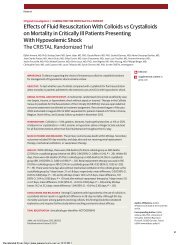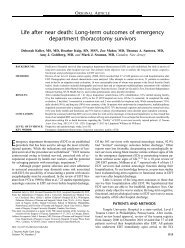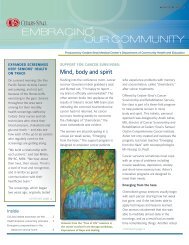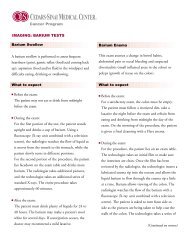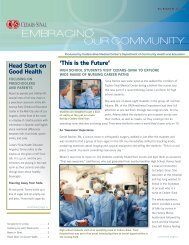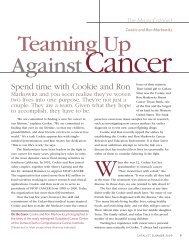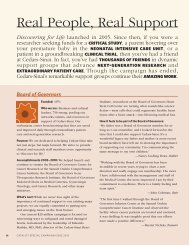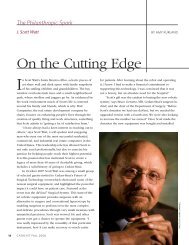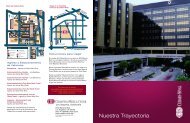Dominant spinal muscular atrophy with lower extremity - Cedars-Sinai
Dominant spinal muscular atrophy with lower extremity - Cedars-Sinai
Dominant spinal muscular atrophy with lower extremity - Cedars-Sinai
You also want an ePaper? Increase the reach of your titles
YUMPU automatically turns print PDFs into web optimized ePapers that Google loves.
<strong>Dominant</strong> <strong>spinal</strong> <strong>muscular</strong> <strong>atrophy</strong> <strong>with</strong> <strong>lower</strong> <strong>extremity</strong> predominance: Linkage<br />
to 14q32<br />
M.B. Harms, P. Allred, R. Gardner, Jr., J.A. Fernandes Filho, J. Florence, A. Pestronk,<br />
M. Al-Lozi and R.H. Baloh<br />
Neurology 2010;75;539-546<br />
DOI: 10.1212/WNL.0b013e3181ec800c<br />
This information is current as of August 10, 2010<br />
The online version of this article, along <strong>with</strong> updated information and services, is<br />
located on the World Wide Web at:<br />
http://www.neurology.org/cgi/content/full/75/6/539<br />
Neurology®<br />
is the official journal of the American Academy of Neurology. Published continuously<br />
since 1951, it is now a weekly <strong>with</strong> 48 issues per year. Copyright © 2010 by AAN Enterprises, Inc.<br />
All rights reserved. Print ISSN: 0028-3878. Online ISSN: 1526-632X.<br />
Downloaded from<br />
www.neurology.org at Washington University on August 10, 2010
M.B. Harms, MD<br />
P. Allred, PT, DPT<br />
R. Gardner, Jr., MD<br />
J.A. Fernandes Filho, MD<br />
J. Florence, PT, DPT<br />
A. Pestronk, MD<br />
M. Al-Lozi, MD<br />
R.H. Baloh, MD, PhD<br />
Address correspondence and<br />
reprint requests to Dr. Robert H.<br />
Baloh, Department of Neurology,<br />
Washington University School of<br />
Medicine, Campus Box 8111,<br />
660 South Euclid Avenue, St.<br />
Louis, MO 63110<br />
rbaloh@wustl.edu<br />
Supplemental data at<br />
www.neurology.org<br />
<strong>Dominant</strong> <strong>spinal</strong> <strong>muscular</strong> <strong>atrophy</strong> <strong>with</strong><br />
<strong>lower</strong> <strong>extremity</strong> predominance<br />
Linkage to 14q32<br />
ABSTRACT<br />
Objective: Spinal <strong>muscular</strong> atrophies (SMAs) are hereditary disorders characterized by weakness<br />
from degeneration of <strong>spinal</strong> motor neurons. Although most SMA cases <strong>with</strong> proximal weakness<br />
are recessively inherited, rare families <strong>with</strong> dominant inheritance have been reported. We aimed<br />
to clinically, pathologically, and genetically characterize a large North American family <strong>with</strong> an<br />
autosomal dominant proximal SMA.<br />
Methods: Affected family members underwent clinical and electrophysiologic evaluation. Twenty<br />
family members were genotyped on high-density genome-wide SNP arrays and linkage analysis<br />
was performed.<br />
Results: Ten affected individuals (ages 7–58 years) showed prominent quadriceps <strong>atrophy</strong>, moderate<br />
to severe weakness of quadriceps and hip abductors, and milder degrees of weakness in<br />
other leg muscles. Upper <strong>extremity</strong> strength and sensation was normal. Leg weakness was evident<br />
from early childhood and was static or very slowly progressive. Electrophysiology and muscle<br />
biopsies were consistent <strong>with</strong> chronic denervation. SNP-based linkage analysis showed a<br />
maximum 2-point lod score of 5.10 ( 0.00) at rs17679127 on 14q32. A disease-associated<br />
haplotype spanning from 114 cM to the 14q telomere was identified. A single recombination<br />
narrowed the minimal genomic interval to Chr14: 100,220,765–106,368,585. No segregating<br />
copy number variations were found <strong>with</strong>in the disease interval.<br />
Conclusions: We describe a family <strong>with</strong> an early onset, autosomal dominant, proximal SMA <strong>with</strong> a<br />
distinctive phenotype: symptoms are limited to the legs and there is notable selectivity for the<br />
quadriceps. We demonstrate linkage to a 6.1-Mb interval on 14q32 and propose calling this<br />
disorder <strong>spinal</strong> <strong>muscular</strong> <strong>atrophy</strong>–<strong>lower</strong> <strong>extremity</strong>, dominant. Neurology ® 2010;75:539–546<br />
GLOSSARY<br />
lod logarithm of the odds; SMA <strong>spinal</strong> <strong>muscular</strong> <strong>atrophy</strong>; SMA-LED <strong>spinal</strong> <strong>muscular</strong> <strong>atrophy</strong>–<strong>lower</strong> <strong>extremity</strong>, dominant;<br />
SNP single-nucleotide polymorphism.<br />
Spinal <strong>muscular</strong> atrophies (SMAs) are hereditary disorders characterized by degeneration of<br />
<strong>spinal</strong> cord motor neurons. The majority of SMA cases show autosomal recessive inheritance<br />
and are caused by homozygous deletion or mutation of the SMN1 gene on 5q (OMIM<br />
253300, 253550, 253400, and 271150). Non-5q SMAs are rare, clinically diverse, and genetically<br />
heterogeneous. 1,2 They are commonly classified by inheritance pattern and whether<br />
weakness involves predominantly distal or proximal musculature.<br />
The non-5q SMAs <strong>with</strong> distal-predominant weakness show phenotypic overlap <strong>with</strong> the<br />
distal hereditary motor neuropathies. Recessive disorders in this category are caused by mutations<br />
in IGHMBP2, 3 PLEKHG5, 4 or show linkage to 9p21.1-p12 5 or 11q.13. 6 <strong>Dominant</strong><br />
From the Department of Neurology (M.B.H., P.A., R.G., J.F., A.P., M.A.-L., R.H.B.), Washington University School of Medicine, St. Louis, MO;<br />
Department of Neurology (J.A.F.F.), University of Nebraska School of Medicine, Omaha; and Hope Center for Neurological Disorders (R.H.B.), St.<br />
Louis, MO.<br />
Study funding: Supported by National Institutes of Health grant NS055980 (to R.H.B.), the Neuroscience Blueprint Core Grant NS057105 (to<br />
Washington University), the Hope Center for Neurological Disorders, the Muscular Dystrophy Association, and the Children’s Discovery Institute.<br />
R.H.B. holds a Career Award for Medical Scientists from the Burroughs Wellcome Fund. The Siteman Cancer Center is supported in part by an NCI<br />
Cancer Center Support Grant P30 CA91842.<br />
Disclosure: Author disclosures are provided at the end of the article.<br />
Downloaded from<br />
www.neurology.org at Washington University Copyright on August © 201010, by AAN 2010 Enterprises, Inc. 539
forms result from mutations in HSPB8, 7<br />
HSPB1, 8 GARS, 9 BSCL2, 10 dynactin-1, 11 or<br />
show linkage to 7q34-q36 12 or 2q14. 13<br />
Other non-5q SMAs demonstrate proximal<br />
or diffuse weakness and demonstrate autosomal<br />
dominant inheritance. These include childhood<br />
autosomal dominant proximal SMA (OMIM<br />
158600), SMA <strong>with</strong> late-onset Finkel type/ALS<br />
8 (OMIM 182980/608627 caused by VAPB<br />
mutations 14 ), scapuloperoneal SMA (OMIM<br />
181405), and congenital benign SMA <strong>with</strong> contractures/congenital<br />
dominant SMA <strong>with</strong> <strong>lower</strong><br />
limb predominance (OMIM 600175). These<br />
last 2 disorders were recently discovered to be<br />
allelic and caused by mutations in TRPV4 at<br />
12q23-34. 15,16<br />
In this study, we describe the clinical, pathologic,<br />
and genetic features of a large North<br />
American family <strong>with</strong> an autosomal dominant<br />
proximal SMA characterized by onset in early<br />
childhood, minimal progression, and an unusual<br />
pattern of selective proximal leg weakness.<br />
The gene for this disorder localizes to a 6.1 Mb<br />
interval on chromosome 14q32.<br />
METHODS Medical histories and neurologic examinations<br />
were obtained from 25 family members (13 men and 12 women)<br />
spanning 4 generations of a North American family. Information<br />
on deceased or unavailable family members was obtained<br />
from relative interviews or genealogic records. A participant was<br />
considered to be affected when examination demonstrated proximal<br />
<strong>lower</strong> <strong>extremity</strong> weakness as assessed by a single senior neuro<strong>muscular</strong><br />
specialist (M.A.-L.). Age at onset was considered to<br />
be the time when parents first noticed muscle <strong>atrophy</strong>, walking<br />
delay, or abnormal gait. Diagnostic EMG/nerve conduction<br />
studies were available and reviewed for 6 affected family members.<br />
All nerve conduction studies had been performed in our<br />
institutional electrodiagnostic laboratory using routine protocols<br />
and laboratory-specific normal values. EMGs were performed<br />
and interpreted by a senior clinical neurophysiologist (M.A.-L.).<br />
Five additional individuals (3 unaffected and 2 affected) consented<br />
to limited EMG of the quadriceps as part of this study.<br />
Slides from 2 muscle biopsies previously obtained for diagnostic<br />
purposes were reviewed. Linkage analysis was performed on 20<br />
family members using single-nucleotide polymorphism (SNP)<br />
genotypes from Affymetrix Genome-wide Human SNP Arrays<br />
(version 5.0 or 6.0). All analyses assumed autosomal dominant<br />
inheritance <strong>with</strong> complete penetrance, a disease allele frequency<br />
of 0.01%, no phenocopies, and Affymetrix “Caucasian” allele<br />
frequencies. Two-point logarithms of the odds (lod) scores were<br />
calculated by FastLink V4.1, 17 while parametric multipoint lod<br />
scores and haplotypes were generated <strong>with</strong> GeneHunter<br />
V2.1r5. 18 Both software packages were accessed through easyLINKAGE<br />
Plus v. 5.08. 19 SNP genotype calling and copy<br />
number analysis utilized Partek Genomics Suite v6.4 (Partek<br />
Inc., St. Louis, MO). Copy number changes were detected using<br />
a genomic segmentation algorithm requiring a minimum of 10<br />
540 Downloaded Neurology 75from August www.neurology.org<br />
10, 2010 at Washington University on August 10, 2010<br />
consecutive probes <strong>with</strong> copy number 2.5 or 1.5. Baseline<br />
copy numbers were derived from International HapMap samples.<br />
SNP numbers and genomic locations reference NCBI Build<br />
36.1 (March 2006).<br />
Standard protocol approvals, registrations, and patient<br />
consents. This study received approval from the Washington<br />
University Human Studies Committee Institutional Review<br />
Board for experiments using human subjects. We obtained written<br />
informed consent from all subjects (or guardians of subjects)<br />
participating in the study.<br />
RESULTS Clinical features. A partial pedigree of the<br />
studied North American family is presented in figure<br />
1. Although participants’ genders have been removed<br />
for anonymity, 5 instances of father-to-son transmission<br />
were observed, supporting an autosomal dominant<br />
mode of inheritance. Penetrance was high in the<br />
complete pedigree (not shown), <strong>with</strong> 45% (29 of 65)<br />
of at-risk individuals known to be affected by family<br />
report or examination. Clinical data from the 10 affected<br />
participants (6 men, 4 women) who were directly<br />
evaluated are presented in the table. The age at<br />
onset, pattern of weakness, and disease course were<br />
consistent across all individuals. Therefore, the proband’s<br />
case history illustrates the phenotype. IV-13<br />
was the product of a normal pregnancy and delivery,<br />
but in infancy his mother noted underdeveloped leg<br />
muscles. He did not walk until 18 months of age and<br />
his running was always slow. He could never climb<br />
stairs <strong>with</strong>out the assistance of a railing, but managed<br />
a career involving upper <strong>extremity</strong> manual labor. His<br />
leg weakness did not progress even into the fifth decade,<br />
when he developed increased leg fatigue and<br />
pain. On examination at age 49, neurologic abnormalities<br />
were limited to <strong>lower</strong> <strong>extremity</strong> weakness<br />
and <strong>atrophy</strong>. No fasciculations were observed. Symmetric<br />
wasting was most prominent in the quadriceps,<br />
but involved distal leg muscles as well (figure<br />
2A). Mild pes cavus deformity was present but there<br />
were no contractures. Quadriceps weakness was severe,<br />
<strong>with</strong> more moderate involvement of hip abduction.<br />
Other muscles, including knee flexors, distal<br />
leg, face, neck, and upper <strong>extremity</strong> muscles showed<br />
normal strength. Sensation was normal to all modalities.<br />
Patellar tendon reflexes were depressed, but all<br />
others were normal. His gait was waddling <strong>with</strong> excessive<br />
lumbar lordosis. Re-examination 4 years later<br />
found no significant decline in measured strength.<br />
Sensory nerve conduction studies showed normal<br />
upper and <strong>lower</strong> <strong>extremity</strong> conduction velocities and<br />
amplitudes. Motor nerve conduction studies of the<br />
upper and <strong>lower</strong> extremities were normal except for<br />
small extensor digitorum brevis amplitudes. EMG<br />
showed large-amplitude (4–20 mV) and longduration<br />
motor unit potentials in most leg muscles<br />
(figure 2B). Neurogenic recruitment patterns were
Figure 1 Spinal <strong>muscular</strong> <strong>atrophy</strong>–<strong>lower</strong> <strong>extremity</strong>, dominant pedigree and haplotype analysis<br />
Gender and birth order have been deidentified to protect family privacy. Filled diamonds denote affected individuals while<br />
open diamonds represent unaffected individuals. A slash indicates deceased individuals. Generations are labeled <strong>with</strong><br />
roman numerals while individuals are identified by numeral. The disease-associated haplotype is shaded in gray. The proband<br />
is marked <strong>with</strong> a large arrow. The small arrow and arrowhead mark recombination events that narrow the overall locus.<br />
Inferred haplotypes are indicated in italics. Eleven descendants of IV-1 are affected by family reports but were not available<br />
for study.<br />
present in all leg muscles, but the severity was variable<br />
and paralleled the degree of muscle weakness.<br />
Although the first dorsal interosseous was normal in<br />
bulk and strength, EMG showed large-amplitude<br />
motor unit potentials but normal recruitment. EMG<br />
of the proximal arm and lumbar para<strong>spinal</strong> muscles<br />
Downloaded from<br />
www.neurology.org at Washington University Neurology on 75 August August 10, 2010 10, 2010 541
Table Clinical characteristics of <strong>spinal</strong> <strong>muscular</strong> <strong>atrophy</strong>–<strong>lower</strong> <strong>extremity</strong>, dominant<br />
Patient no.<br />
Age, y<br />
Onset Examination<br />
was normal. No spontaneous activity was found in<br />
any muscle.<br />
As <strong>with</strong> the proband, most affected individuals<br />
were recognized in the first 2 years of life. Three individuals<br />
were detected somewhat later in childhood<br />
(ages 4–7 years). IV-3 underwent heel cord release<br />
surgery before the age of 10. The indication for this<br />
release is unknown, but there was no history of toe<br />
walking in IV-3, nor in any other affected individual.<br />
None of the 10 participants examined had arthrogryposis<br />
or contractures, but 5 individuals had mild pes<br />
cavus. Prior diagnoses for affected family members<br />
include poliomyelitis (IV-4 and IV-5), limb girdle<br />
<strong>muscular</strong> dystrophy (V-4, IV-8), and congenital myopathy<br />
(V-6). The quadriceps muscle was most severely<br />
affected in all individuals, but the degree of<br />
weakness in other leg muscles varied. No patients<br />
had detectable arm or neck weakness. Leg weakness<br />
was static or only slowly progressive, <strong>with</strong> the oldest<br />
individual walking unassisted at age 58.<br />
Nerve conduction studies in an additional 5 affected<br />
family members (IV-8, IV-10, V-4, V-5, and<br />
V-6) showed normal sural sensory responses. In the 3<br />
younger patients (V-4, V-5, and V-6), the tibial and<br />
peroneal motor studies were also normal. In the 2<br />
older patients, tibial and peroneal motor studies were<br />
normal except for a single small compound muscle<br />
action potential amplitude in each (extensor digitorum<br />
brevis in IV-8 and abductor hallucis in IV-<br />
10). EMG of all 5 individuals showed chronic<br />
denervation in both proximal and distal leg muscles,<br />
but in all cases the quadriceps showed the<br />
most severely reduced recruitment. Limited EMG<br />
of the quadriceps in 2 additional affected individ-<br />
Weak muscles, a MRC score Reflexes: knee, ankle b Pes cavus EMG<br />
IV-10 1 50 KE0,HF4 0,2 No NA<br />
IV-11 1 46 KE 3, ADF 4 0, 0 No Neurogenic<br />
IV-13 1 49 KE 2, HA 4 1, 2 Yes Neurogenic<br />
IV-3 7 58 KE 3 1, 2 Yes Neurogenic<br />
IV-4 6 55 KE 3, HA 4 1, 2 No Neurogenic<br />
IV-8 1 53 KE 3, HF 4, KF 4 0, 2 No Neurogenic<br />
V-4 2 33 KE 3, HA 4 NA Yes Neurogenic<br />
V-5 4 24 KE 4 1, 2 Yes Neurogenic<br />
V-6 1 24 KE 2, HF 4, KF 4, ADF 4 NA Yes Neurogenic<br />
VI-1 1 7 NA 0, 2 No NA<br />
Abbreviations: ADF ankle dorsiflexion; HA hip abduction; HF hip flexion; KE knee extension; KF knee flexion; NA <br />
not assessed or available; NCS nerve conduction studies.<br />
a Muscles are only listed if Medical Research Council (MRC) score was 5. MRC strength scoring: 5 normal strength, 4 <br />
weak, 3 full range against gravity, 2 full range <strong>with</strong> gravity removed, 1 visible contraction.<br />
b Reflex scoring: 2 normal, 1 reduced, 0 absent.<br />
542 Downloaded Neurology 75from August www.neurology.org<br />
10, 2010 at Washington University on August 10, 2010<br />
uals (IV-3 and IV-4) also showed severe neurogenic<br />
changes. Upper limb EMG was available for<br />
V-6 only, showing no abnormalities in the deltoid<br />
and first dorsal interosseous. Quadriceps EMG in<br />
3 clinically unaffected individuals (IV-6, V-1, and<br />
V-2) was normal.<br />
Quadriceps biopsies were available for 2 participants<br />
(IV-8 and V-4). IV-8 (age 26) had chronic partial<br />
denervation (figure 2, C and D), type II muscle<br />
fiber predominance, and inflammatory cell foci surrounding<br />
several perimysial blood vessels. V-4 (age 2)<br />
had end-stage muscle <strong>with</strong> atrophic fibers and type II<br />
muscle fiber predominance, but no inflammation<br />
(not shown).<br />
Genetic studies. Genome-wide linkage analysis identified<br />
SNPs on chromosomes 3, 9, and 14 <strong>with</strong><br />
2-point lod scores 3.0 (figure 3A). Fine mapping of<br />
these 3 regions using additional SNPs identified a<br />
maximum 2-point lod score of 5.10 ( 0.00) on<br />
14q32 at SNP rs17679127. An additional 33 SNPs<br />
in the region had 2-point lod scores 3.0 ( 0.00)<br />
(figure 3B). Linkage to 14q32 was further supported<br />
by multipoint parametric LOD scores of 3.00 over<br />
the 6.4-Mb (16 cM) interval between rs2615453 and<br />
rs10143250 (figure 3C). A disease-associated haplotype<br />
from 114 cM through the telomere at 14q<br />
(rs734313 to rs8011590) was shared by all affected<br />
members of the family (figure 1). No unaffected individuals<br />
carried the at-risk haplotype. A recombination<br />
between rs11620937 and rs1981266 in<br />
individual IV-7 narrowed the centromeric boundary<br />
to 126 cM. No telomeric recombinations were observed,<br />
leaving a minimal genomic interval of 6.1 Mb
Figure 2 Spinal <strong>muscular</strong> <strong>atrophy</strong>–<strong>lower</strong> <strong>extremity</strong>, dominant phenotype and muscle pathology<br />
(A) Leg <strong>atrophy</strong> in the proband (IV-13) was most pronounced in quadriceps, but also present in muscles of the <strong>lower</strong> leg. (B)<br />
Neurogenic giant motor unit potentials on EMG of the quadriceps in the proband (IV-13). (C) Hematoxylin-eosin–stained<br />
frozen section of the vastus medialis muscle (patient IV-8). Changes include internal nuclei, fiber splitting, muscle fiber<br />
hypertrophy, and <strong>atrophy</strong>. Small muscle fibers are angular (black arrow). (D) In another region, cellular infiltrate surrounds a<br />
perimysial vessel (white arrowhead). Bar 30 m.<br />
(Chr14:100,220,765–106,368,585). Because highdensity<br />
SNP arrays were used for genotyping, we employed<br />
a genomic segmentation algorithm to assess<br />
copy number variation across chromosome 14. No<br />
segregating duplications or deletions were found.<br />
Fine mapping of 3q27 showed only a single SNP<br />
<strong>with</strong> lod score of 3.00 ( 0.00), while 7 SNPs <strong>with</strong><br />
lod scores 3.00 were identified at 9q34 (maximal<br />
lod score 3.09, 0.00) (figure e-1 on the Neurology ®<br />
Web site at www.neurology.org). However, these<br />
loci were excluded after regional multipoint lod<br />
scores were negative (figure e-2) and no diseaseassociated<br />
haplotypes could be reconstructed.<br />
DISCUSSION We identified a large North American<br />
family <strong>with</strong> dominantly inherited proximal <strong>lower</strong><br />
<strong>extremity</strong> weakness. All affected individuals were recognized<br />
in childhood and showed the same pattern<br />
of proximal leg weakness <strong>with</strong> a striking predilection<br />
for the quadriceps. The clinical histories we obtained<br />
suggest static or very slowly progressive weakness, but<br />
our follow-up has been too brief to objectively document<br />
this feature.<br />
The EMG findings and myopathology were consistent<br />
<strong>with</strong> a chronic neurogenic etiology, but could not<br />
distinguish between loss of anterior horn cells and degeneration<br />
of motor axons. On clinical grounds, however,<br />
the absence of length-dependent weakness in this<br />
family argues against a motor neuropathy and the overall<br />
phenotype meets diagnostic criteria for a SMA. 20 In<br />
further support of classification as a SMA, other families<br />
<strong>with</strong> similar early-onset, proximal neurogenic weakness<br />
have historically been considered to have SMA and categorized<br />
as childhood/juvenile proximal SMA, 21 autosomal<br />
dominant SMA III, 22 or proximal hereditary<br />
motor neuronopathy type IV. 23 Therefore, we propose<br />
calling this disease <strong>spinal</strong> <strong>muscular</strong> <strong>atrophy</strong>–<strong>lower</strong> ex-<br />
Downloaded from<br />
www.neurology.org at Washington University Neurology on 75 August August 10, 2010 10, 2010 543
Figure 3 Linkage analysis of the <strong>spinal</strong> <strong>muscular</strong> <strong>atrophy</strong>–<strong>lower</strong> <strong>extremity</strong>, dominant pedigree<br />
(A) Two-point linkage analysis of single-nucleotide polymorphism (SNP) markers spaced every 0.05 cM was performed,<br />
showing SNPs <strong>with</strong> logarithm of the odds (lod) scores 3.00 on chromosomes 3, 9, and 14. (B) Two-point linkage analysis<br />
<strong>with</strong> all Affymetrix GenomeWide 5.0 SNPs on distal 14q showed additional SNPs <strong>with</strong> significant lod scores. (C) Multipoint<br />
linkage analysis using SNPs spaced at 1-cM intervals (and increased around potential recombination sites) across distal<br />
14q.<br />
tremity, dominant (SMA-LED) to reflect its likely site<br />
of pathology, notable quadriceps involvement, and inheritance<br />
pattern.<br />
The SMA-LED phenotype is unusual and can be<br />
distinguished from most other reported cases of autosomal<br />
dominant proximal SMA 24 by the absence of<br />
clinically apparent upper <strong>extremity</strong> involvement.<br />
None of the participating SMA-LED family members<br />
had detectable upper <strong>extremity</strong> weakness or <strong>atrophy</strong><br />
on examination. The proband showed mild,<br />
subclinical, chronic denervation in the hand, but his<br />
child did not. This finding suggests that upper <strong>extremity</strong><br />
involvement is related to length of disease or<br />
that there is intrafamilial variability. Because upper<br />
limb EMG was only available for these 2 family<br />
544 Downloaded Neurology 75from August www.neurology.org<br />
10, 2010 at Washington University on August 10, 2010<br />
members, we could not distinguish between these 2<br />
possibilities. Lower <strong>extremity</strong> predominance has<br />
been described in several other dominant SMA<br />
families, 25-27 including the one family <strong>with</strong> a mutation<br />
in TRPV4 on 12q23-q24. 15,16,28,29 However, in<br />
contrast to SMA-LED, these pedigrees showed more<br />
prominent distal leg weakness, high rates of arthrogryposis,<br />
and congenital onset. Although the features<br />
of SMA-LED are different from most other autosomal<br />
dominant SMAs, we cannot exclude the possibility<br />
that SMA-LED represents one end of a spectrum<br />
shared <strong>with</strong> these other families. The SMA-LED<br />
phenotype most closely resembles 3 previously described<br />
small families, 27,30,31 matching their age at onset,<br />
proximal <strong>lower</strong> <strong>extremity</strong> predominance, and
mild or absent progression. However, these case descriptions<br />
did not include enough clinical information<br />
to judge whether pronounced quadriceps<br />
involvement was present.<br />
The SMA-LED quadriceps biopsies we analyzed<br />
were consistent <strong>with</strong> chronic denervation. In contrast<br />
to the type I muscle fiber predominance typically<br />
found in autosomal dominant proximal SMA, 27 both<br />
SMA-LED biopsies showed prominent type II muscle<br />
fiber predominance. Similar type II predominance<br />
has been reported in one other family. 28 The<br />
degree of fiber type predominance we have observed<br />
could originate from several potential mechanisms.<br />
First, successive rounds of denervation <strong>with</strong> reinnervation<br />
could produce what amounts to severe fiber<br />
type grouping. Alternatively, the SMA-LED pathologic<br />
process could selectively spare type II motor<br />
units or specifically target type I motor units. Finally,<br />
some authors have hypothesized that the absence of<br />
fiber type grouping, the onset of symptoms in utero<br />
or in early infancy, a lack of ongoing denervation,<br />
and static or minimally progressive weakness all argue<br />
for a defect of motor neuron embryogenesis<br />
rather than for motor neuron degeneration. 27 In this<br />
family, the presence of giant motor units on EMG is<br />
most consistent <strong>with</strong> successive rounds of denervation<br />
and reinnervation. We also found perivascular<br />
inflammation in one muscle biopsy. This inflammation<br />
is of uncertain significance. Perivascular mononuclear<br />
cell inflammation is a frequent finding in<br />
some hereditary neuro<strong>muscular</strong> disorders, including<br />
fascioscapulohumeral dystrophy 32 and the dysferlinopathies,<br />
33 but to our knowledge, has not been reported<br />
for any SMA. Additional pathologic studies<br />
are needed to clarify whether inflammation is a consistent<br />
finding in SMA-LED.<br />
By genetic linkage studies we have identified the<br />
locus for SMA-LED on 14q32. SMA-LED is the first<br />
dominantly inherited SMA to show linkage to this<br />
region. Interestingly, a recessively inherited, severe<br />
SMA that is accompanied by pontocerebellar hypoplasia<br />
(SMA-PCH1 OMIM 607596) also localizes<br />
to 14q32. Null mutations in vaccinia-related kinase 1<br />
(VRK1) were recently identified as the causative genetic<br />
defect. 34 Although the VRK1 gene is nearby, it<br />
is 3.6 Mb outside the minimal genomic interval for<br />
SMA-LED. According to the UCSC database, the<br />
genomic region we have identified spans 6.1 Mb and<br />
contains 73 known or predicted genes. Identification<br />
of the causative gene mutation in SMA-LED will<br />
have important implications for the pathogenesis of<br />
motor neuron diseases.<br />
AUTHOR CONTRIBUTIONS<br />
Statistical analysis was conducted by Dr. M.B. Harms.<br />
ACKNOWLEDGMENT<br />
The authors thank the SMA-LED family for participation in this research,<br />
Shaughn Bell for assistance <strong>with</strong> DNA preparation, Dr. Christine Gurnett<br />
for technical assistance, and the Alvin J. Siteman Cancer Center at Washington<br />
University School of Medicine and Barnes-Jewish Hospital in St.<br />
Louis, MO, for use of the Center for Biomedical Informatics and Multiplex<br />
Gene Analysis Genechip Core Facility.<br />
DISCLOSURE<br />
Dr. Harms, Dr. Allred, Dr. Gardner, and Dr. Fernandes Filho report no<br />
disclosures. Dr. Florence serves on a scientific advisory board for Prosensa;<br />
serves on the editorial board of Neuro<strong>muscular</strong> Disorders; and serves as a<br />
consultant for PTC Therapeutics, Inc. and Acceleron Pharma. Dr. Pestronk<br />
serves on the scientific advisory board of the Myositis Association;<br />
has served on a speakers’ bureau for and received speaker honoraria from<br />
Athena Diagnostics, Inc.; owns stock in Johnson & Johnson; is director of<br />
the Washington University Neuro<strong>muscular</strong> Clinical Laboratory which<br />
performs antibody testing and muscle and nerve pathology analysis, procedures<br />
for which the Washington University Neurology Department<br />
bills; may accrue revenue on patents re: TS-HDS antibody, GALOP antibody,<br />
GM1 ganglioside antibody, and Sulfatide antibody; has received<br />
license fee payments from Athena Diagnostics, Inc. for patents re: antibody<br />
testing; and receives/has received research support from Genzyme<br />
Corporation, Insmed Inc., Knopp Neurosciences Inc., Prosensa, Isis Pharmaceuticals,<br />
Inc., sanofi-aventis, the NIH (5R01NS04326407 [site PI]),<br />
CINRG Children’s Hospital Washington DC, and from the Muscular<br />
Dystrophy Association. Dr. Al-Lozi and Dr. Baloh report no disclosures.<br />
Received January 19, 2010. Accepted in final form April 26, 2010.<br />
REFERENCES<br />
1. Pestronk A. Hereditary motor syndromes. Available at:<br />
http://neuro<strong>muscular</strong>.wustl.edu. Accessed November 16,<br />
2009.<br />
2. Zerres K, Rudnik-Schoneborn S. 93rd ENMC International<br />
Workshop: non-5q-<strong>spinal</strong> <strong>muscular</strong> atrophies<br />
(SMA): clinical picture. Neuromuscul Disord 2003;13:<br />
179–183.<br />
3. Grohmann K, Schuelke M, Diers A, et al. Mutations in the<br />
gene encoding immunoglobulin mu-binding protein 2<br />
cause <strong>spinal</strong> <strong>muscular</strong> <strong>atrophy</strong> <strong>with</strong> respiratory distress type<br />
1. Nature Genet 2001;29:75–77.<br />
4. Maystadt I, Rezsohazy R, Barkats M, et al. The nuclear<br />
factor kappa-beta-activator gene PLEKHG5 is mutated in<br />
a form of autosomal recessive <strong>lower</strong> motor neuron disease<br />
<strong>with</strong> childhood onset. Am J Hum Genet 2007;81:67–76.<br />
5. Christodoulou K, Zamba E, Tsingis M, et al. A novel form<br />
of distal hereditary motor neuronopathy maps to chromosome<br />
9p21.1-p12. Ann Neurol 2000;48:877–884.<br />
6. Viollet L, Barois A, Rebeiz JG, et al. Mapping of autosomal<br />
recessive chronic distal <strong>spinal</strong> <strong>muscular</strong> <strong>atrophy</strong> to<br />
chromosome 11q13. Ann Neurol 2002;51:585–592.<br />
7. Irobi J, Van Impe K, Seeman P, et al. Hot-spot residue in<br />
small heat-shock protein 22 causes distal motor neuropathy.<br />
Nature Genet 2004;36:597–601.<br />
8. Evgrafov OV, Mersiyanova I, Irobi J, et al. Mutant small<br />
heat-shock protein 27 causes axonal Charcot-Marie-Tooth<br />
disease and distal hereditary motor neuropathy. Nature<br />
Genet 2004;36:602–606.<br />
9. Antonellis A, Ellsworth RE, Sambuughin N, et al. Glycyl<br />
tRNA synthetase mutations in Charcot-Marie-Tooth disease<br />
type 2D and distal <strong>spinal</strong> <strong>muscular</strong> <strong>atrophy</strong> type V.<br />
Am J Hum Genet 2003;72:1293–1299.<br />
10. Windpassinger C, Auer-Grumbach M, Irobi J, et al. Heterozygous<br />
missense mutations in BSCL2 are associated<br />
Downloaded from<br />
www.neurology.org at Washington University Neurology on 75 August August 10, 2010 10, 2010 545
<strong>with</strong> distal hereditary motor neuropathy and Silver syndrome.<br />
Nature Genet 2004;36:271–276.<br />
11. Puls I, Jonnakuty C, LaMonte BH, et al. Mutant dynactin<br />
in motor neuron disease. Nature Genet 2003;33:455–<br />
456.<br />
12. Gopinath S, Blair IP, Kennerson ML, et al. A novel locus<br />
for distal motor neuron degeneration maps to chromosome<br />
7q34-q36. Hum Genet 2007;121:559–564.<br />
13. McEntagart M, Norton N, Williams H, et al. Localization<br />
of the gene for distal hereditary motor neuronopathy VII<br />
(dHMN-VII) to chromosome 2q14. Am J Hum Genet<br />
2001;68:1270–1276.<br />
14. Nishimura AL, Mitne-Neto M, Silva HCA, et al. A mutation<br />
in the vesicle-trafficking protein VAPB causes lateonset<br />
<strong>spinal</strong> <strong>muscular</strong> <strong>atrophy</strong> and amyotrophic lateral<br />
sclerosis. Am J Hum Genet 2004;75:822–831.<br />
15. Deng HX, Klein CJ, Yan J, et al. Scapuloperoneal <strong>spinal</strong> <strong>muscular</strong><br />
<strong>atrophy</strong> and CMT2C are allelic disorders caused by alterations<br />
in TRPV4. Nature Genet 2009;42:165–169.<br />
16. Auer-Grumbach M, Olschewski A, Papic L, et al. Alterations<br />
in the ankyrin domain of TRPV4 cause congenital<br />
distal SMA, scapuloperoneal SMA and HMSN2C. Nature<br />
Genet 2009;42:160–164.<br />
17. Cottingham RW Jr, Idury RM, Schäffer AA. Faster sequential<br />
genetic linkage computations, Am J Hum Genet<br />
1993;53:252–263.<br />
18. Kruglyak L, Daly MJ, Reeve-Daly MP, Lander ES. Parametric<br />
and nonparametric linkage analyses: a unified multipoint<br />
approach. Am J Hum Genet 1996;58:1347–1363.<br />
19. Hoffmann K, Lindner TH. EasyLINKAGE Plus: automated<br />
linkage analyses using large-scale SNP data. Bioinformatics<br />
2005;21:3565–3567.<br />
20. Zerres K, Davies KE. 59th ENMC International Workshop:<br />
<strong>spinal</strong> <strong>muscular</strong> atrophies: recent progress and revised diagnostic<br />
criteria. Neuromuscul Disord 1999;9:272–278.<br />
21. Pearn J. Autosomal dominant <strong>spinal</strong> <strong>muscular</strong> <strong>atrophy</strong>.<br />
J Neurol Sci 1978;38:263–275.<br />
22. Rudnik-Schöneborn S, deVisser M, Zerres K. Spinal <strong>muscular</strong><br />
atrophies. In: Engel AG, Franzini-Armstrong C, eds.<br />
Myology. New York: McGraw-Hill; 2004:1845–1864.<br />
23. Harding AE. Inherited neuronal <strong>atrophy</strong> and degeneration<br />
predominantly of <strong>lower</strong> motor neurons. In: Dyck PJ,<br />
Be a Leader, Stand Out<br />
Thomas PK, eds. Peripheral Neuropathy. Philadelphia:<br />
Elsevier Saunders; 2005:1603–1621.<br />
24. Rudnik-Schöneborn S, Wirth B, Zerres K. Evidence of autosomal<br />
dominant mutations in childhood-onset proximal <strong>spinal</strong><br />
<strong>muscular</strong> <strong>atrophy</strong>. Am J Hum Genet 1994;55:112–119.<br />
25. Frijns CJM, van Deutekom J, Frants RR, Jennekens FGI.<br />
<strong>Dominant</strong> congenital benign <strong>spinal</strong> <strong>muscular</strong> <strong>atrophy</strong>.<br />
Muscle Nerve 1994;17:192–197.<br />
26. Mercuri E, Messina S, Kinali M, et al. Congenital form of<br />
<strong>spinal</strong> <strong>muscular</strong> <strong>atrophy</strong> predominantly affecting the <strong>lower</strong><br />
limbs: a clinical and muscle MRI study. Neuromuscul Disord<br />
2004;14:125–129.<br />
27. Reddle S, Ouvrier RA, Nicholson G, et al. Autosomal<br />
dominant congenital <strong>spinal</strong> <strong>muscular</strong> <strong>atrophy</strong>: a possible<br />
developmental deficiency of motor neurons?. Neuromuscul<br />
Disord 2008;18:530–535.<br />
28. Fleury P, Hageman G. A dominantly inherited <strong>lower</strong> motor<br />
neuron disorder presenting at birth <strong>with</strong> associated arthrogryposis.<br />
J Neurol Neurosurg Psychiatry 1985;48:<br />
1037–1048.<br />
29. van der Vleuten A, van Ravenswaaij-Arts C, Frijns C, et al.<br />
Localisation of the gene for a dominant congenital <strong>spinal</strong><br />
<strong>muscular</strong> <strong>atrophy</strong> predominantly affecting the <strong>lower</strong> limbs<br />
to chromosome 12q23-q24. Eur J Hum Genet 1998;6:<br />
376–382.<br />
30. Emery AE. The nosology of the <strong>spinal</strong> <strong>muscular</strong> atrophies.<br />
J Med Genet 1971;8:481–495.<br />
31. Garvie JM, Woolf AL. Kugelberg-Welander syndrome<br />
(hereditary proximal <strong>spinal</strong> <strong>muscular</strong> <strong>atrophy</strong>). BMJ 1966;<br />
1:1458–1461.<br />
32. Arahata K, Ishihara T, Fukunaga H, et al. Inflammatory<br />
response in facioscapulohumeral <strong>muscular</strong> dystrophy<br />
(FSHD): immunocytochemical and genetic analyses. Muscle<br />
Nerve 1995;(suppl 2):S56–S66.<br />
33. McNally EM, Ly CT, Rosenmann H, et al. Splicing<br />
mutation in dysferlin produces limb-girdle <strong>muscular</strong><br />
dystrophy <strong>with</strong> inflammation. Am J Hum Genet 2000;<br />
91:305–312.<br />
34. Renbaum P, Kellerman E, Jaron R, et al. Spinal <strong>muscular</strong><br />
<strong>atrophy</strong> <strong>with</strong> pontocerebellar hypoplasia is caused by<br />
a mutation in the VRK1 gene. Am J Hum Genet 2009;<br />
85:1–9.<br />
If you are a Fellow of the American Academy of Neurology, please consider applying for the AAN<br />
Board of Directors—or nominate a colleague—by September 30, 2010. Learn more and apply at<br />
www.aan.com/view/BOD.<br />
546 Downloaded Neurology 75from August www.neurology.org<br />
10, 2010 at Washington University on August 10, 2010
<strong>Dominant</strong> <strong>spinal</strong> <strong>muscular</strong> <strong>atrophy</strong> <strong>with</strong> <strong>lower</strong> <strong>extremity</strong> predominance: Linkage<br />
to 14q32<br />
M.B. Harms, P. Allred, R. Gardner, Jr., J.A. Fernandes Filho, J. Florence, A. Pestronk,<br />
M. Al-Lozi and R.H. Baloh<br />
Neurology 2010;75;539-546<br />
DOI: 10.1212/WNL.0b013e3181ec800c<br />
Updated Information<br />
& Services<br />
Subspecialty Collections<br />
Permissions & Licensing<br />
Reprints<br />
This information is current as of August 10, 2010<br />
including high-resolution figures, can be found at:<br />
http://www.neurology.org/cgi/content/full/75/6/539<br />
This article, along <strong>with</strong> others on similar topics, appears in the<br />
following collection(s):<br />
All Neuro<strong>muscular</strong> Disease<br />
http://www.neurology.org/cgi/collection/all_neuro<strong>muscular</strong>_diseas<br />
e Anterior nerve cell disease<br />
http://www.neurology.org/cgi/collection/anterior_nerve_cell_disea<br />
se All Genetics<br />
http://www.neurology.org/cgi/collection/all_genetics Genetic<br />
linkage<br />
http://www.neurology.org/cgi/collection/genetic_linkage<br />
Information about reproducing this article in parts (figures, tables)<br />
or in its entirety can be found online at:<br />
http://www.neurology.org/misc/Permissions.shtml<br />
Information about ordering reprints can be found online:<br />
http://www.neurology.org/misc/reprints.shtml<br />
Downloaded from<br />
www.neurology.org at Washington University on August 10, 2010



